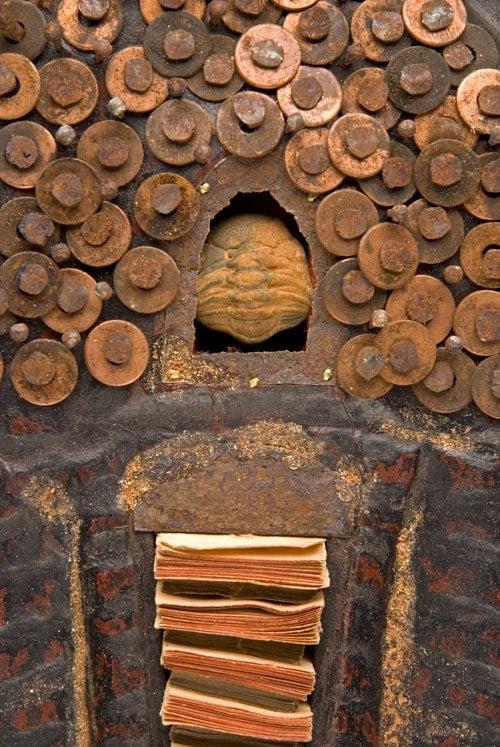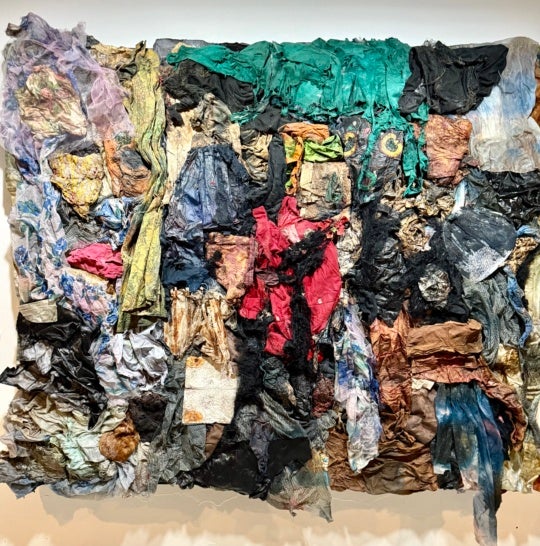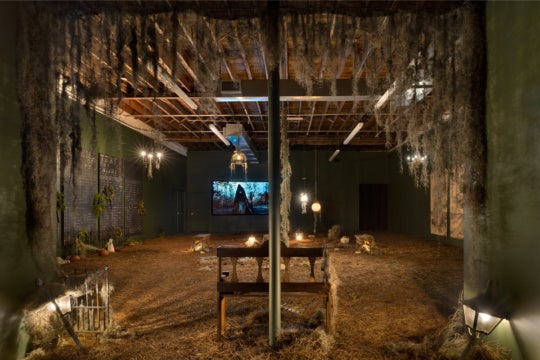
On March 13 and 14, 2012, Atlanta-based artist Gyun Hur created a temporary installation, spiritus lenis (smooth breathing), in the arboretum at Wesleyan College in Macon as a part of its annual Lamar Lecture Series. The communal and performative aspects of the work were especially exciting, developing themes that have been present in Hur’s work but are now emerging more distinctly as a new and productive direction for the artist.
Hur is perhaps best known for her beautiful abstract rainbow-striped sculptures made of finely shredded silk flowers. The largest example, Spring Hiatus, she created over several weeks as a temporary piece at Lenox Square Mall as one of the Flux Projects public art works in February and March of 2011. The installation, like several of Hur’s previous works recreates Hur’s mother’s traditional Korean silk wedding blanket through a laborious process of chopping flowers into powdery pigments and spreading them precisely, band by band, then carefully extracting any stray color fragments with tweezers.

Spring Hiatus is a piece whose most immediate themes—cultural identity, personal history, memory—seem like ample material for a lifetime of further exploration, but Hur says she’s ready to move on. A recent trip to Korea, the artist’s first since she left that country at age 13 for the United States with her family, closed that particular chapter of her work, she says. Indeed, in the arboretum work, Hur seemed to be setting aside the previously dominant thread of personal history and identity and picking up a different one, developing the previous work’s aspects of performance, collaboration, and relational aesthetics.

Spring Hiatus involved Hur working alongside her parents and other family members for many hours to create the pigments and carefully lay them out line by line. The creation of the work at one of Atlanta’s busiest places also involved numerous points of intersection with the public, some of which surprised Hur. Passersby asked about the work, regular mall-goers observed and commented on the progress, and employees in nearby shops and department stores became ‘“volunteer docents” when customers asked about what was going on outside. Hur says that the employees not only explained that it was a public artwork, but also became invested in talking about the details of the work, as well: that it was a piece recreating her mother’s wedding blanket, that it was made of powdered silk flowers, that the family was participating, and so on.

At one point, a boy tossed a green Starburst candy from the second floor balcony into the middle of the work, where it landed on a contrasting color (a different artist might have interpreted this act as an assault on personal identity, disempowered to the point that even a teenager feels at liberty to denigrate its quiet public expression). But Hur says, “I think he was just curious.” She remained undaunted, and the work seems to have aroused a parallel curiosity in her about various ways the public might interact with a work. Walking into the piece to pick up the candy would have destroyed the delicate pattern, so communal problem-solving came into play: the group brainstormed with onlookers and eventually used a long stick to reach in and retrieve the candy.

The Flux Projects commissions were designed to bring about a change in the public’s relationship to art, but what’s interesting is that Spring Hiatus seems to have accelerated an interest on Hur’s part in exploring her relationship to the public. The artist also points to dance performances she has seen as developing that interest, as well, particularly a 2009 performance by the Trisha Brown Dance Company that she attended at the Brooklyn Academy of Music. Hur says that a quote she came across in the article “A Collection in Flux” by Jeannie Rosenfeld (Art in America, November 2011) helped her better understand where she could go with her interest in space, time, movement, and collaboration: “His [Merce Cunningham’s] improvisational approach, embracing the element of chance put forth by his musical director and life partner John Cage, fostered his collaborators’ own artistic envelopment while advancing his notion of dance as ‘an art in space and time.’ … A veritable ‘movement movement’ is afoot, with choreographers appearing more consistently at fine art venues, and artists increasingly using dance as medium or subject.” Hur invited two dancers from Atlanta company gloATL to perform around the Wesleyan installation on the afternoon of the second day of her residency.

The installation, built in and around a cabin in the arboretum, consisted of three physical parts. In one room of the cabin, around its old stone fireplace, Hur spread some of her silk flower pigment in a radiating pool of green. Though the acidic color was from a new palette, the work seemed primarily designed to familiarize students with Hur’s past practices and materials. Outside the cabin, between pairs of tree trunks, Hur wound string in alternating colors, usually starting with an earthy brown and switching to vivid yellows and pinks, thus mirroring in abstract bands the changes and colors of the woods in early spring. Lastly, Hur used rounded river rocks to create a sort of bed of stones arranged in gentle, organic lines. In each of these processes, Hur was assisted by visiting classes of Wesleyan students (in every field from biology to printmaking). The process of building, participation, learning, and collaboration were central to the work, almost more so than the objects themselves. The seemingly disparate elements were brought together through the interaction of people.

Hur points out that the materials and processes for the arboretum works were intentionally simple: ordinary river stones, a single color for the interior floor, and string from Wal-Mart. Part of her intention, she says, was to demystify the art-making process, to suggest that artistic practices can be adopted by anyone: they are not then solely the realm of the uniquely and mysteriously gifted.
Overall, the atmosphere in the woods was convivial, active, busy, fun (Hur even brought along a bubble machine—the artist as master fun-maker). Whereas her previous work seemed quiet, personal, contemplative, abstract, laborious, singularly related to the personal history and identity of the artist, the new work was more invitational, open, and communal. (But it was also interesting to note that when the pieces were unpeopled during a break, they became tinged with more than a little melancholy. An element of stillness, imperishability, inaccessibility, and absence pervaded, contrasting with the optimism and openness that went into their creation. The wound strings even suggested an unplayed, or unplayable, musical instrument, a sort of silent, unrealized potential).

The piece came stunningly back to life when student musicians Jessie Spannagel on oboe and Danielle Ross on flute improvised a soundscape for two dancers of gloATL, Nicole Johnson and Mary Jane Pennington. The dancers made their entrance by emerging from the woods and arriving at the installation slowly, organically, like migrating animals. Their abstract movements always suggested but never specified dramatic relationships with the pieces and each other.

“Artists make something out of nothing,” is a little aphorism ’that has always rung true for me: it describes the outrageous level of inventiveness required in any artistic endeavor. But Hur did something even more impressive: she made something and someplace and sometime out of string from Wal-Mart. The afternoon was impressive for its open improvisation that resulted in work with such a tight aesthetic focus. Especially memorable was hearing Hur gently guide students in the placement of the stones and later catching a glimpse of her hand as it darted into the work to grab a stray twig and flick it as far from the work as possible, its presence an insulting intrusion quickly and reflexively, almost angrily, dismissed. Hur’s is a very specific, overarching aesthetic inviting participation in its realization.
The afternoon of experiment involved a loosening of roles—artist, viewer, student, teacher, dancer, audience—a tight grip releasing. The dancers frequently used a gesture that suggested a loosening or release, fingers twitching, slowly spreading. It’s rare to encounter an amazingly talented artist at the early stages of her career, much less to encounter her at a fascinating time of transition.
Wesleyan College is a private, liberal arts women’s college located in Macon, Georgia. For more information on upcoming events held on campus, visit their website.




